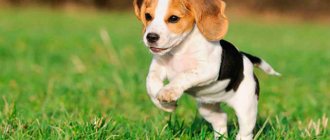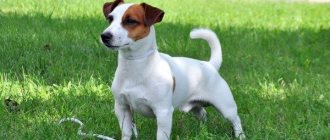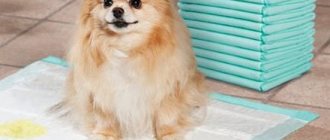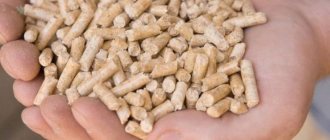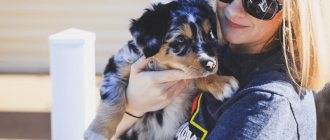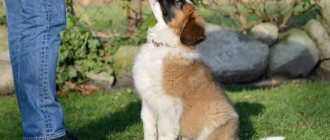What is a dog diaper?
A diaper for dogs is a universal hygiene product, presented in the form of a small mat that absorbs moisture well. The product comes in two types – disposable and reusable.
Disposable product
Disposable diapers contain filling inside and a waterproof layer at the bottom. When they stop absorbing moisture, they must be thrown away - they cannot be washed. This option is suitable if you don’t like doing laundry at all and are willing to regularly spend money on diapers.
Reusable product
Reusable products are an ideal option for training your pet to wear a diaper. They are made of dense soft fabric that is difficult to tear and can be safely washed and dried. Inside, instead of filler, there is a special membrane layer that instantly absorbs moisture, so the dog’s paws do not get wet. The fabric is treated with antibacterial and antifungal agents.
The diaper can absorb up to 3 liters of liquid, so it is suitable even for mature puppies of medium and large breeds aged 6-12 months. One square meter of product can absorb 2 liters of moisture.
Why diaper train a puppy?
Tray training your pet will help get rid of:
- puddles in the apartment at every step;
- unexpected piles;
- pungent ammonia odor of urine and feces.
When your baby grows up, it will be easier for you to teach your dog to relieve himself only on the street, since he will get used to going to a specially designated place.
You should also remember about vaccination. The first vaccination is given at 8 weeks, the second after 2 weeks, then quarantine for 10 days. Until this moment, the dog cannot walk in the yard, otherwise he may pick up a fatal infection. During this period, a diaper and a tray will save half the apartment.
How long does it take to train a puppy to wear a diaper?
How long it takes to accustom your pet to a diaper depends on your patience and the dog’s character. Don't expect your dog to understand the order the first time, it may take several weeks. Much depends on the age (older puppies learn the task faster), the dog’s intelligence, and your persistence.
The baby will quickly figure out what's what if you keep an eye on him and take him to the diaper as soon as he decides to have a bowel movement (immediately after waking up, feeding, active games). When the pet can more or less control the process of urination, it will go to a specially designated place.
Learning to use the litter tray
Before you bring your puppy into the house, you need to think about which rooms he is not allowed to enter and fence them off using a special mesh. You can also use this mesh to make an enclosure for your puppy, which will contain toys, a tray and a bowl for food and water. You need to spread a rag soaked in dog urine in the tray; this smell will attract the pet to fulfill its natural needs. If the puppy has chosen his own place for the toilet, you need to lay newspapers there, and eventually put a tray. Usually dogs get used to going to the toilet on the newspaper, and in the future there are no problems.
In most cases, the animal wants to go to the toilet after eating, drinking water or playing for a long time. If you systematically plant it on a tray, the result will not be long in coming.
The speed of learning depends on the age at which you began to accustom your pet to the tray. With the right approach to training, you can teach an adult dog to go to the toilet outside or in the litter box.
How to train a puppy to wear a diaper: basic rules
There are secrets, the use of which will make it easier for your dog to toilet train. Basic rules on how to train a puppy to wear a diaper at home:
- Babies love to defecate on soft surfaces that subconsciously resemble grass.
- Dogs quickly learn to urinate where they can smell their urine.
- Small dogs defecate immediately after sleeping or feeding.
- Pets love cleanliness, incl. in the place where they go to the toilet.
- Provide your pet with the opportunity to easily reach the diaper.
How to train a dog to pee on a diaper at home: find a place for the toilet
Think about a place for the dog toilet in advance. It shouldn't be in a place where people walk frequently. Select a secluded corner accessible to the baby - a corridor, an area near the door, a kitchen. You can install a toilet in the bathroom, but this is not an ideal option. Firstly, the door should always be open, and secondly, the puppy may not have time to “run.”
Choose a place so that you can quickly move your pet to the dog toilet. Fence the area, put a diaper. Leave a place nearby with an uncovered floor where he can stay until he relieves himself. Make sure your pet defecates on the diaper. After this, praise the dog and release it into the wild.
How to train a dog to wear a diaper in an apartment: buy a holder
To prevent the material from folding or creasing when the puppy uses it, buy a special holder. It will keep the product taut. Alternatively, you can put weights along the edges so that they don’t get wet and start to stink; protect them with a diaper or oilcloth.
How to train a dog to toilet in a diaper: take away all soft coverings
Hide all carpets and keep your pet out of carpeted rooms. Puppies love to defecate on soft, absorbent material. The diaper is soft, pleasant, and if the baby does not find a carpet, he will be happy to relieve himself on it. It will quickly become saturated with urine, and next time the dog will come here by smell.
How to accustom a one-month-old puppy to a diaper: toilet ritual
The little dog urinates often, but there are times when he always does it. The owner should know about them and take the baby immediately when the action occurs:
- The dog woke up, but had not yet crawled out of the crib.
- After feeding.
- After or during active play.
As soon as the baby relieves himself in the diaper, be sure to praise him, stroke him, and give him a treat.
How to toilet train a puppy in an apartment: keep the area around the diaper clean
Although dogs prefer to relieve themselves in places where they have already urinated, they will not get into a puddle, remains of feces, or dirt. Remove feces in a timely manner and wash the diaper. If a disposable product no longer absorbs moisture, replace it.
How to accustom a puppy to a diaper in an apartment: free access to a diaper
The dog should be able to go to the toilet whenever he wants. Make sure that he does not go far from the diaper and is constantly near it. If you suspect your baby will relieve himself soon, place him in a fenced area near the dog litter box. As soon as the dog has emptied, praise it and take it out of the pen.
How to properly toilet train a puppy: never punish
Do not scream, do not intimidate the baby, do not poke your face into the urine. This way you can achieve the opposite result. When the dog grows up, he will worry that he won’t be able to endure it... and out of fear, he will leave a puddle. Sometimes in the apartment, sometimes on the staircase, as soon as he leaves the confines of his home. This behavior is difficult to correct and can accompany the dog for the rest of its life.
If the puppy left a puddle, you can point to it and express your dissatisfaction with words in a reproachful tone. The effect will only be if the remark was made within the first seconds after the incident. If the moment is missed, even a few minutes have passed, the baby will not understand why he is being scolded. In this case, the puppy must be at least 3 months old.
How to train a dog to pee on a diaper: clean the floor thoroughly if the puppy goes to the toilet in the wrong place
If your pet has done its business in the wrong place, carefully clean the floor. To avoid stains and odors, use special dog cleaning products (Mr.Fresh, 8IN1 Natures Miracle Stain/Odor Remover). If you don't clean up your puppy thoroughly, there's a good chance he'll relieve himself here a second time.
How to teach a dog to wear a diaper: you cannot change the location of the toilet
The puppy must know exactly where he can defecate. If he is curious and follows you around the apartment, make several dog toilets in different rooms. As they grow older, they can be removed one at a time, but after that you need to monitor the pet for some time, directing it to the right place.
Nuances worth paying attention to
How quickly you potty train your little friend depends on his individual characteristics. But still, pay attention to some points. If the breeder has a puppy trained to use the litter box, then you don’t need to expect him to go to the toilet in your house too. Remember, he was taken from his usual place, a new apartment and people are stressful for him and therefore you will have to train him again. Only this will not take a long period, since the puppy will soon remember all the skills.
There is no need to scold the puppy if you catch him doing something, but not in the litter box. Take him and put him there. When you see the puppy sit down on the floor. Just sharply say “ugh” to him, clapping your hands, then pick him up and take him to the potty. Silently clean up after the baby if he has managed to do a mischief.
You can also use disposable special diapers, which you can buy along with trays in our online store. Instead, the owner can try laying an old sheet, torn into suitable pieces, that can be used several times. Although diapers specially purchased for this purpose will still look aesthetically pleasing.
It's good if you can keep an eye on the puppy during the night's rest. Then, when they are in a sleepy state, it is easier to control them. The puppy will get out of his place and his eyes will be closed, he will go to do his job (of course, it is most convenient for him to recover on the floor). Although if you transfer it to the tray in this state, it will not offer resistance to you. He will just do everything he needs and go on to rest.
You can use newspapers and cover the entire floor with them. You can also teach your puppy to go first to the newspaper, and then only to the tray. But remember, your baby loves to play with everything that rustles, which means you will have to clean the floor more, as there will be a mess of newspapers. Yes, and you still have to retrain. This method is not very justified, since it takes more time to potty train the puppy, and you will have to clean up more.
There is another positive aspect of your dog being able to use the litter box. Imagine this: you wake up on a day off, you still want to sleep off after a hard week of work, and then you need to take your dog outside. And this must be done despite the frosty morning, rain and slush. So with dog litter boxes you can afford to rest longer.
As the puppy gets older, the tray will need to be changed. Twice in his life. It is best to choose a plastic tray. Plastic does not react with urine. Never yell at or hit your dog while you are training him to go to the toilet in a litter box at home, otherwise you will lose trust and respect. Every time your four-legged friend goes to the right place, praise him and reward him with a treat.
Sources:
https://zooidea.ru/article/24/288/
https://sobaky.info/kak-priuchit-shhenka-k-lotku/
https://www.toppet.ru/articles/kak-priuchit-sobaku-hodit-v-tualet-v-lotok-doma.html
How to train a dog to use a litter box in an apartment
The litter tray is tamed no earlier than the pet has mastered the diaper. For a long time, the litter box was only a cat attribute, but recently models have appeared designed for puppies and dogs of dwarf breeds. It is a flat container with small sides. Their use allows not only to accustom the dog to the tray, but also to save the floor from accidental leaks.
Some models have a grate at the bottom, which allows you to avoid using filler that absorbs liquids and unpleasant odors.
When choosing a tray, you need to consider the following points:
- Material – choose products made from high quality plastic. They are safe and last a long time.
- Sides – for small dogs you need low sides, for older and larger dogs – medium ones.
- Gender of the dog - there are trays on sale with a post on which male dogs can urinate. It is not needed for females, nor for small puppies - they begin to raise their paws after 6-7 months.
Features of training a puppy to the tray
Before you can train your dog to use the litter box, he must master the diaper. This is especially true for small puppies who find it difficult to climb over the side. Once your baby has mastered the diaper, move it to the tray. Do not put on a new product; the diaper should smell like puppy urine.
Further actions should be done by analogy with diaper training. Immediately after sleeping, feeding or active play, place the baby directly in the tray and praise him when he goes to the toilet. If your pet constantly “misses”, place one of the diapers under the tray.
If the diaper is in the tray, do not wash it with strong products that kill the smell - the pet will lose interest in it. If he doesn't like the smell of the disinfectant, he will go looking for a new place for the toilet.
Features of organizing a toilet space in the house
You need to start preparing to organize a toilet for your pet by choosing a location. It is best to place a tray or lay a diaper near doors and windows, focusing on where the toilet will not interfere with a person, but at the same time it should be comfortable for the animal to get to the potty. If we are talking about a very small puppy, then it is necessary to organize several places for trips when needed. You need to lay a diaper where the dog peed; the more newspapers are laid around the house, the sooner the dog will understand what is required of him. Over time, you need to remove one diaper at a time and by 4 months the dog should already get used to peeing in the same place.
Monitor the animal, choosing the most favorable conditions for it to defecate - this is very important when it comes to a puppy. Some people need a calm atmosphere and a dark corner, while others need space and the opportunity to spin around while choosing a toilet area. In addition to plastic pallets, you can choose other devices that are used as a symbol for a toilet. Among these tools are the following:
- newspaper is a temporary measure that allows you to outline the boundaries of the toilet, which has pronounced absorbent properties. The newspaper does not hold urine, so the puddle spreads widely throughout the room and the floor under it remains wet. The newspaper is used as a tool to indicate the location of the potty (the leaf is moistened in the puppy’s fresh puddle, after which it is immediately wiped off, and the wet page is placed in the potty, transferring the corresponding smell to where it should be - this will allow the dog to better navigate in the future and quickly find the “right toilet” );
- diaper - a cloth or rubberized material that has more pronounced absorbent and retention properties. The diaper is used as an independent space for the toilet, but it is much more correct to place it on the bottom of the tray, since the floor will still get wet under the diaper. If linoleum, laminate or parquet is laid on the floor, this material will absorb the smell of urine well, which you will not be able to get rid of in the future;
- a tray is a special device with a large number of modifications and shapes that allows you to completely prevent leakage and create comfortable conditions for the dog to cope with its natural needs. The trays are easy to wash, which makes them universal tools, optimally suited for small breeds of dogs living in an apartment.
Features of organizing a toilet for different breeds of dogs
Organization of a puppy's toilet largely depends on its breed. Owners of small dog breeds (Yorkshire terrier, Chihuahua, Pekingese, Spitz, miniature poodle, etc.) strive to accustom their pets to a tray or diaper. This makes it easier to keep an animal in an apartment building and saves time on daily walks. Here everything depends on the desire of the owner; small dogs, if trained, run to the toilet and outside with great pleasure, so whether or not to take the dog out for a walk is the choice of the person himself.
As for large breeds of dogs (Rottweiler, Shepherd, Bull Terrier, Husky), such puppies must be taught to walk and go to the toilet exclusively outside the home from a very early age. As a rule, large dogs are eager to go for a walk, so difficulties with toilet discipline rarely arise.
We have a Pomeranian Spitz in our family - a small dog, but we have had great difficulties with toilet training. The pet did not want to acknowledge the purchased tray and wrote wherever he wanted. As a result, we managed to interest the animal in diapers made from ordinary fabric - this is not convenient, since they get wet and you have to constantly wash them, but the puddles around the house have almost disappeared. Lately, the Spitz has been showing great interest in the street, constantly asking at the door and he himself associates this with the need to defecate. It’s fortunate that we live in a private house, since the dog is not going to tolerate it, and asks for it a good dozen times a day. As a result, 2 years have already passed since the acquisition of the pet, and trips to the toilet are organized as follows: 3 walks a day at the same time, and a diaper in the house for the remaining episodes.
Types of dog trays
Today there are a huge number of types of trays that need to be selected taking into account the characteristics of a particular animal and its breed. Let's look at the most common models:
- toilet with a column. It is a classic version of a pot, consisting of a tray and a mesh that is laid on top. The main component of the device is a removable post that allows male dogs to relieve themselves in a physiological position, with their hind paw raised. This is the optimal type of toilet suitable for small breed dogs. The pot requires daily washing of the tray and grid, does not absorb the smell of urine and is not toxic. If a tray is purchased for a puppy, then at first you should use only water to wash it; the strong smell of detergents can scare away the dog;
A tray with a column is necessary for male dogs, as it allows them to relieve themselves in an anatomically comfortable position - tray with collector. The simplest version of a dog toilet, equipped with a plastic tray and a grate that prevents dog paws from stepping into the puddle. The mesh is removable, so the tray is very easy to wash. There are several modifications of this toilet - with high and low sides. A potty with a high side has a special passage for the dog and is suitable for males who will pee on the inside of the side, while a potty with a low side is suitable for females. Depending on the size of the dog, the tray may have different sizes;
A tray with a collector is the most convenient design for puppies of small and medium breed dogs - toilet with filler. This potty option is more suitable for cats, as they have an instinctive need to bury themselves; many dogs do not have this habit. In some cases, these toilet options are purchased for decorative dog breeds, as they have a number of advantages. The structure of the tray is very simple - it is a pallet with an average height of the sides, into which filler is poured, chosen at the discretion of the owner. Dry litter absorbs urine and masks the odor. There is also a drawback due to which dog owners are not recommended to use them - dogs often eat toilet litter, which can lead to poisoning of the animal or intestinal obstruction; A tray with litter is rarely used for toilet training dogs, however, some breeds of puppies prefer this “privacy” option.
- toilet with changing diapers. This version of the tray is a flat tray with fastenings for a diaper, which is fixed at the bottom of the pot. This is a very convenient option for both the dog and the owner. The dog has the opportunity to stand and spin around on a stable surface while relieving itself. In this case, the urine does not spread, but is absorbed into the mat. There are both classic disposable diapers and reusable mats with special filling that can be washed. The tray itself does not absorb odor, is easy to clean and protects the floor from leaks;
The diaper tray is easy to use and easy to clean - Tray-lawn. It is a three-level structure, in the lower part of which there is a capacious box for urine, the middle layer is a protective mesh with the function of blocking odors, and the upper part is represented by an imitation of a lawn. The grass is made of rubberized material, which is easy to care for and allows moisture to pass inside the container. The pot is easy to disassemble and wash; the manufacturer indicates that the toilet can be washed every few days without fear of the unpleasant odor that remains inside the container. There are also more advanced designs that have a self-cleaning system by spraying with water.
The lawn tray allows you to create the feeling of a dog going to the toilet on the lawn
Homemade version of a dog tray
At the stage of accustoming the animal to relieve itself in a designated place, you can save money and build a potty yourself. In some cases, this temporary measure allows you to create an imitation of a tray and save on buying a store-bought toilet. Let's look at some options:
- basin with sand. This is not the most successful device, since not all dogs are comfortable getting into the basin, but it is a measure that can be useful. Among the disadvantages, it can be noted that the dog spreads sand throughout the house on its paws, and the sand is not able to contain the smell and needs to be changed regularly;
- linoleum. To create a pot, you can use a piece of linoleum, in which you need to bend the edges with a boat and fasten them together with a construction stapler or using screws and nuts. Rubber shoe mats are placed at the bottom of the toilet to prevent the dog's paws from getting wet. The design is easy to maintain, but quickly absorbs urine and develops an unpleasant odor over time.
By fastening the sides of a piece of linoleum with screws, you can build a temporary toilet for a dog of any size
Features of training different breeds of dogs
The technique for training a puppy to use a diaper or litter tray is the same, but take into account the dog’s character:
- Toy terrier, chiahua, yorkie and other small active dogs. These breeds have a fast metabolism, so they defecate frequently. At the same time, the puppies are active and curious. To train them to use a litter tray, they need to be limited in space or have several toilets installed, constantly monitoring them. As you grow older, the number of diapers can be removed.
- Spitz. Representatives of this species are characterized by insatiable curiosity, regardless of size. It is difficult to contain it in a confined space, so make several toilets.
- Labradors. Puppies of this breed are very smart and easy to train, so there should be no problems. Every time he empties in the right place, praise him and give him a treat.
- Huskies are dogs with a complex character. Until 6 months of age, they do not want to control their urination, so when toilet training your puppy, you need to be patient.
Purchased tools for potty training a dog
Store-bought products for developing a strong puppy habit of relieving themselves in a designated place are an excellent option for owners who do not have time to monitor every step of the animal. These drugs are presented in the form of sprays containing special enzymes that attract the dog and make it want to urinate. Products in this category are completely harmless to animals and people, do not cause allergies and do not spread a persistent odor throughout the house. Manufacturers claim that it is possible to achieve complete toilet training of a pet using specialized sprays in two weeks.
To use the product, you need to spray the composition on a diaper, the surface of a potty or a newspaper lying in the place designated for the toilet. After this, you need to take the puppy to the tray and sit him next to him. You should not force the dog to sniff the potty - she will become interested and come up to sniff. It is necessary to spray the surface at least twice a day, gradually spraying less and less product. Let's highlight a few of the most popular toilet sprays:
- Api-San Smart spray. It is a 200 ml bottle with a sprayer. The composition includes an anionic surfactant, fragrances, distilled water and a natural odor emulator;
Api-San Smart spray is an effective tool for quickly toilet training a dog - SaniPet. Spray with a volume of 250 milliliters, including vanillin, anionic odor emulator, essential oils, propanol and isopropyl myristate;
SaniPet is a convenient and effective product that allows you to train not only a puppy, but also an adult dog to use the tray. - Simple Solution Puppy aid training spray. Spray made in the USA with a convenient spray nozzle, 480 ml bottle. The product contains purified water, fatty acids, natural odor analogues and acidity regulators.
Simple Solution Puppy aid training spray - a modern spray for training dogs of any age and breed to use a tray or diaper
How to teach a puppy to use the toilet outside using a diaper and a litter tray?
In order for the puppy to learn to relieve himself outside, he needs to be walked 4-5 times a day. From six months, the number of walks can be reduced to 3 times.
Praise when your pet relieves himself outside, and at home lament over every puddle he makes in the wrong place. At this age, the puppy begins to understand what is required of him, does not want to upset the owner and tolerates it. It is very important to walk him 1-2 times during the day, otherwise the process of accustoming him to walking will take up to a year.
When the puppy is 6-7 months old, gradually move the diaper and tray to the front door. When you realize that your puppy is not eliminating as often as before, take the diaper and keep an eye on your pet. When he begins to get restless and spin around in the place where the toilet used to be, immediately take him outside before he has a bowel movement.
If you don’t have time, you can “cry” out loud over the puddle, but never scream or poke the dog’s face into the puddle. After some time, the puppy will ask to go for a walk. Remember that a young dog must be walked at least 3 times a day, otherwise puddles will appear periodically. If you cannot provide this need when leaving home, leave a tray or diaper.
Rules for toilet training a puppy
Usually a puppy comes to its owners from breeders at two months - this is exactly the age at which a dog can and should be toilet trained. For up to two months, the dog cannot stand it and pees as soon as the need arises. The very procedure of training a litter box or outdoors takes some time, so when getting a little companion you need to be patient. On average, the process takes from several days to several months - it all depends on the technique used and the nature of the animal.
There are several recommendations that will help your dog develop an understanding that it is necessary to relieve himself in a specific place. They are built on the basis of the physiological characteristics of the animal. The puppy feels the need to defecate after sleep and after eating, for this reason, it is necessary to take the dog to a diaper or outside every time it eats or sleeps. If the pet coped with it and did everything right, then it should be praised and petted, which will help reinforce the action through a positive experience.
If a dog, especially a puppy, is punished, scolded or beaten after defecating in the wrong place, then the animal will develop an unpleasant experience that will be associated with the punishing person. Such measures are not effective, but only cause fear in the owner. Dog handlers do not recommend poking a dog’s nose in urine or yelling at it - this is not always easy, but the process of raising an animal requires a certain concentration, effort and time. Only a healthy and calm atmosphere will contribute to the positive consolidation of experience and the repetition of actions leading to praise.
Dog handlers say that you should never punish a puppy for making a puddle on the floor.
The main tool that the owner of a young dog can use is a routine and systematic action. Train yourself and your pet to eat at the same time, followed by a long walk outside. If you know your puppy's routine, you will soon understand when your pet needs to urinate, which will completely eliminate the appearance of unauthorized puddles on the floor.
It is necessary to monitor the puppy at first, trying to understand the peculiarities of its behavior, since its change may indicate that the dog is now going to the toilet. It is necessary to catch such moments - this will allow you to promptly take the animal to the place where it will later have to relieve itself (street or tray). It will not always be possible to carry the dog to the intended toilet, but the pet will already begin to compare the need and a specific location and, when the urge arises, will run in the required direction. We can identify the following behavioral features of an animal that will indicate its intention to defecate:
- worry and anxiety;
- the puppy begins to quickly run around the room, spin around or sit down;
- whining;
- digging the floor.
Another important detail that ensures moderate trips to the toilet is high-calorie food that is well and quickly absorbed. If food is poorly digested, then the need to stool becomes more frequent, for this reason you should give the puppy high-quality food or put balanced food in his bowl, which will contain cereals, fruits, vegetables, meat and dairy products.


